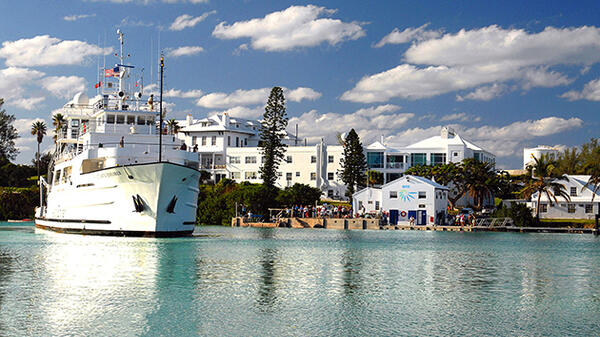BIOS is one of thirteen academic and research institutions participating in a newly-announced National Science Foundation (NSF) Science and Technology Center (STC) intended to develop a deeper understanding of the role that marine microbes play in changing ocean conditions and the global carbon cycle. Over the next five years, the STC will leverage recent scientific advances, incorporate new technologies, and engage educators and policymakers to promote a deeper understanding of the chemicals and chemical processes that underpin ocean ecosystems.
Good News for Three Long-Term Ocean-Monitoring Programs at BIOS
October 30, 2021

BIOS senior scientist and director of research Nick Bates boosted his research portfolio earlier this month when he received news of three funding renewals for long-term ocean-monitoring programs at BIOS.
Shipboard Teamwork
October 25, 2021

During the last two years, a team of researchers and technicians from BIOS have worked diligently alongside crew of the BIOS-operated research vessel Atlantic Explorer to maintain near-continued operations throughout the pandemic.
Tracing a Water Journey
October 14, 2017

In the Southern Ocean, cold surface water sinks to about 1,500 feet (500 meters) and travels in the dark for thousands of miles before resurfacing, some 40 years later, near the equator in the Pacific, Atlantic, and Indian ocean basins. Scientists call this major water mass the Sub-Antarctic Mode Water, or SAMW, and it is regarded as a powerhouse of a mixer in the oceans. It’s also critical to marine life; when it warms and rises into the sunlit subtropical and tropical waters, the nutrients it contains are estimated to fuel up to 75 percent of the microscopic plants growing there.
BIOS Scientists Set to Participate in International Research Expedition to the Arctic
November 30, 2021

Not many people willingly sign up for a multi-week research cruise in freezing temperatures where fresh produce typically runs out after the second week at sea. But BIOS research specialist Becky Garley is excited at the prospect of returning to the Arctic for the third time next September 2022 as part of the Synoptic Arctic Survey (SAS).
Exploring Dynamics of Reef Function
November 14, 2017

Coral reefs present scientists with a unique challenge. How do you accurately measure ecosystem processes—such as photosynthesis and calcification—within a system that changes over the course of a day and between days (depending on water flow, tides, sunlight, and weather, among other factors) and that also contains a variety of reef types and habitats (such as rim reefs, in-shore reefs, and deep water reefs)?
Tiny Algae, Surprising Findings
March 13, 2017

Chemical oceanographer Nick Bates’s ongoing study of the ocean-atmosphere interface sheds light on a group of tiny, beautiful marine plants called coccolithophores, which have been found to release carbon dioxide into the atmosphere in regions near Antarctica.
Unprecedented, Man-made Trends in Ocean’s Acidity
February 26, 2012
As part of the natural carbon cycle, atmospheric CO2 reacts with the ocean’s surface waters to become carbonate, which can be converted by marine organisms into calcium carbonate. Many marine organisms—including corals, mussels, and algae—rely on calcium carbonate to build their shells or skeletons, making the molecule an important part of marine processes.
Under-Researched Marine Organisms Play Larger than Life Role in Ocean Chemistry
August 26, 2012

Earlier this year, scientists wrapped up the second research cruise, as part of a multi-year project investigating a feature of the Southern Ocean known as the Great Southern Coccolithophore Belt (Great Belt). Coccolithophores are a type of phytoplankton with a unique exoskeleton composed of calcified platelets (coccoliths), giving them the appearance of being heavily armored.
North Atlantic Ocean Absorbing Less CO2 Than Originally Thought
October 27, 2012

For many years scientists have operated on the belief—backed by extensive calculations and climate models—that the global ocean absorbs approximately 30% of the atmospheric carbon dioxide (CO2) produced by human activities. However, in a recent paper published in the journal Biogeosciences, Dr. Nicholas Bates, Senior Scientist and Associate Director of Research at the Bermuda Institute of Ocean Sciences (BIOS), discovered this might not always be true.
